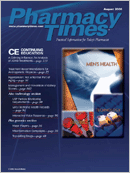Publication
Article
Pharmacy Times
Generic Times: Product Profiles
Author(s):
Pravastatin Tablets
Clinical Update
The collection of symptoms thatcomprise the metabolic syndromeaccompanies an increased risk of cardiovasculardisease and type 2 diabetes.The risk factors for the syndromeinclude elevated blood pressure,increased plasma glucose levels,and dyslipidemia. Although initial treatmenthas its primary focus on lifestylemodification, with emphasis on weightreduction, increased physical activity,and a restructured diet, drug therapyoften is introduced to counteract thesespecific risk factors.
Hydroxymethylglutaryl coenzyme A(HMG-CoA) reductase inhibitors, commonlyknown as statins, are among themost commonly prescribed drugs forthe control of lipid disorders. A recentaddition to those statins availablegenerically is pravastatin.
Pharmacology
Statins, such as pravastatin, competitivelyinhibit the enzyme HMG-CoAreductase, a catalyst to the conversion ofHMG-CoA to mevalonic acid, an earlyprecursor to cholesterol.
Administration and Dosing
For adult treatment of hyperlipidemiaor for the prevention of coronaryevents, pravastatin is dosed at 40mg daily, increasing at 4-week intervalsto a maximum daily dose of 80 mg.Children 8 to 13 years old tolerate 20mg daily; those up to 18 years old maytake 40 mg daily. Dosing of pravastatinshould be timed either 1 hour before or4 hours following the use of eithercolestipol or cholestyramine.
Adverse Effects and DrugInteractions
Whereas up to 5% of patients using astatin drug may experience muscle disorders,fatalities from myopathy are factoredat less than 1 per million of thecombined prescriptions for all currentlymarketed statin preparations.
The risk factors surrounding thedevelopment of statin-based myopathiesinclude advanced age, alcoholabuse or hepatic disease, diabetes,chronic renal insufficiency, and hypothyroidism.Ironically, some of these riskfactors contribute to dyslipidemia andthe need for statin therapy. Prior totreatment with a statin, baseline creatinekinase (CK) and thyroid-stimulatinghormone levels should beobtained, both to monitorfor statin-induced CK elevationslater on and todetermine whether a thyroidmalfunction is contributingto the dyslipidemia.
Patients should bewarned of the potential formyopathy and be told toreport any muscle pain orweakness to their physiciansimmediately. Patientsshould be interviewedregarding their muscle condition 6 to 12weeks after starting therapy and witheach physician visit. Sources also recommendstopping statin therapy beforemajor surgery or prior to planned strenuousactivity such as running a marathon.
The risk of myopathy increases ifpravastatin is given concurrently withgemfibrozil. Patients using any statin willbenefit from the addition of coenzymeQ10 (CoQ10, or ubiquinone) as a meansto counteract the potential for myopathyat daily doses of 60 to 120 mg. CoQ10generally is well-tolerated and has no significantadverse effects.
In addition, a recent Danish studyfound that patients using a statin are 14times more likely to develop peripheralneuropathy than those in the generalpopulation. Pravastatin is not extensivelymetabolized by the isozyme cytochromeP450 3A4 (CYP3A4), with a lesser potentialfor drug interactions.
Outlook
As a class of drugs, statins will becomeincreasingly prescribed as cholesterolgoals are lowered and the drugs' indicationsare expanded. Recent studies implythat statin use may lower the lifetime riskof Alzheimer's disease, lower cardiovascularrisk among the elderly, and providebenefits to postmenopausal women.Pravastatin has the advantage of fewerCYP3A4-based interactions and is now ina more economical generic form. Pravastatincurrently is available from TevaPharmaceutical Industries Ltd in 10-, 20-,and 40-mg tablets.
Simvastatin
Clinical Update
At least 100 million Americans havetotal cholesterol levels exceeding 100mg/dL; 40 million have levels over 240mg/dL. Current treatment guidelines forhypercholesterolemia encourage a significantreduction in low-density lipoprotein (LDL). To date, the statins representthe most effective drug treatment for thereduction of LDL cholesterol. Statins,such as simvastatin, reduce circulatinglipoproteins through interference withmevalonate, an intermediary in thebiosynthesis of cholesterol.
Pharmacology
Simvastatin is an antilipidemic agentthat is useful with dietary and lifestylechanges for preventing cardiovascularevents and dyslipidemia and for reducingtriglyceride levels. In addition, it has beenshown to reduce the progression of atherosclerosisin coronary arteries and tolower the risk for postsurgical thromboticcomplications following artery bypassgrafting.
Dosing
Simvastatin should be dosed on anindividual basis according to patientresponse. Serum lipoproteins should bechecked 4 weeks after initiation of treatmentand periodically thereafter.
The initial adult daily dose for simvastatinis 20 to 40 mg taken in the evening.Monthly adjustments can follow, with amaximum suggested dailydose of 80 mg. Althoughsimvastatin has beenadministered to children asyoung as 10 years of age,daily doses above 40 mghave not been evaluated.
In patients being treatedfor the condition known ashomozygous familial hypercholesterolemia,the recommendedadjunctive doseof simvastatin is 40 mg inthe evening or a multiple-dosingregimen of two 20-mg doses during the day,with a 40-mg dose in theevening.
Because of an increasedrisk of myopathy, patientstaking simvastatin concurrentlywith cyclosporineshould begin with only a 5-mg dose and not exceed adaily regimen of 10 mg.
Adverse Effects
The risk for myopathy is the greatestconcern with statin therapy. In additionto the restrictions surrounding concurrenttreatment with cyclosporine, simvastatinmay interact with other drugs toincrease this risk. Muscle conditionshould be examined 6 to 12 weeks afterinitial dosing and with each physicianvisit. Sources also recommend stoppingstatin therapy before major surgery orprior to planned prolonged strenuousactivity.
Patients using any statin at daily dosesof 60 to 120 mg will benefit from the additionof coenzyme Q10 (CoQ10; ubiquinone)to counteract the potential for myopathy.CoQ10 has no significant adverse effectsand is generally well-tolerated.
The combination of simvastatin andgemfibrozil should be avoided, and concurrentuse of niacin should beapproached cautiously. If employed, themaximum daily simvastatin dose is 10mg. In addition, patients taking amiodaroneor verapamil should restrict simvastatinto a daily intake of 20 mg.
Patients should be advised that simvastatinshares the toxic potential ofother statins, especially the risk for rhabdomyolysis.Commercial combinations ofsimvastatin with other agents, such asezetimibe, do little to minimize that risk.
Outlook
The enthusiasm for statin therapy continuesto grow. One of the obstacles tohaving patients share that enthusiasmhas traditionally been the cost. With theappearance of simvastatin in genericforms, economical options are emergingto treat what is regarded as an epidemicof high cholesterol. Additionally, studiessuggest that statins such as simvastatinmay lower the lifetime risk of Alzheimer'sdisease, reduce cardiovascular riskamong the elderly, and provide benefitsto postmenopausal women.
FDA approval for generic simvastatinin 5-, 10-, 20-, 40-, and 80-mg tablets hasbeen granted to Teva PharmaceuticalIndustries Ltd and Ranbaxy Laboratories.Dr. Reddy's Laboratories has exclusiverights from Merck for an authorizedgeneric.
Mr. Middleton is an instructor of pharmacologyat Kellogg CommunityCollege in Battle Creek, Mich.







